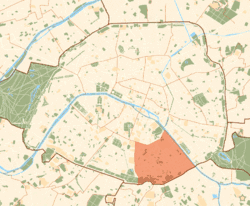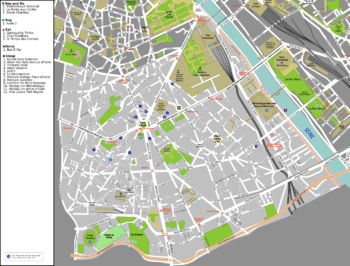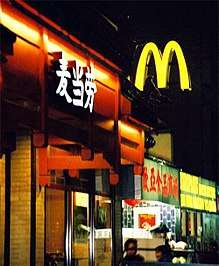13th arrondissement of Paris
The 13th arrondissement of Paris (XIIIe arrondissement) is one of the 20 arrondissements of the capital city of France. In spoken French, this arrondissement is referred to as treizième.
13th arrondissement of Paris XIIIe arrondissement | |
|---|---|
 Paris and its closest suburbs | |
| Country | France |
| Region | Île-de-France |
| Department | Paris |
| Commune | Paris |
| Government | |
| • Mayor | Jérôme Coumet |
| Area | |
| • Total | 7.15 km2 (2.76 sq mi) |
| Population (2017-01-01)[1] | |
| • Total | 182,099 |
| • Estimate (2005) | 181,300 |
| • Density | 25,000/km2 (66,000/sq mi) |
| 1 Population sans doubles comptes: single count of residents of multiple communes (e.g. students and military personnel). | |
 Paris Coat of Arms 20 arrondissements of Paris | |||||||||||||||||||||||||||||||||||||
|---|---|---|---|---|---|---|---|---|---|---|---|---|---|---|---|---|---|---|---|---|---|---|---|---|---|---|---|---|---|---|---|---|---|---|---|---|---|
| |||||||||||||||||||||||||||||||||||||
The arrondissement, called Gobelins, is situated on the left bank of the River Seine. It is home to Paris's principal Asian community, the Quartier Asiatique, located in the southeast of the arrondissement in an area that contains many high-rise apartment buildings. The neighborhood features a high concentration of Chinese and Vietnamese businesses.[2] The current mayor is Jérôme Coumet (Socialist), who was re-elected by the arrondissement council on 29 March 2008 after the list which he headed gained 70% of the votes cast in the second round of the 2008 French municipal elections, and was again re-elected on 13 April 2014.
The 13th arrondissement also hosts the Bibliothèque François Mitterrand and the newly built business district of Paris Rive Gauche.
Demographics
The 13th arrondissement is still growing in population, mainly because of an influx of Asian immigrants. During the late 1970s and early 1980s, the first wave of Vietnamese refugees from the Vietnam War settled in the arrondissement, largely concentrated near Masséna Boulevard. Later waves of refugees and Asian immigrants transitioned from being exclusively ethnic Vietnamese to include ethnic Chinese from Vietnam, Laotians and Cambodians. These migrants largely settled in the southern area of the arrondissement, creating an Asian quarter and establishing a commercial district and community institutions.[3] Teochew, Cantonese, Vietnamese, Lao and Khmer are spoken by many residents in the community.
At the last census in 1999, the population was 171,533. The 13th arrondissement is also rapidly growing in business activity, thanks to the new business district of Paris Rive Gauche. In 1999, the arrondissement contained 89,316 jobs, and it is believed to contain more today.
Historical population
| Year (of French censuses) |
Population | Density (inh. per km2) |
|---|---|---|
| 1872 | 69,431 | 12,342 |
| 1954 | 165,620 | 23,164 |
| 1962 | 166,709 | 23,329 |
| 1968 | 158,280 | 22,149 |
| 1975 | 163,313 | 22,854 |
| 1982 | 170,818 | 23,904 |
| 1990 | 171,098 | 23,943 |
| 1999 | 171,533 | 24,004 |
| 2009 (peak of population) | 182,032 | 25,459 |
Immigration
| Born in Metropolitan France | Born outside Metropolitan France | |||
|---|---|---|---|---|
| 76.2% | 23.8% | |||
| Born in Overseas France |
Born in foreign countries with French citizenship at birth1 | EU-15 immigrants2 | Non-EU-15 immigrants | |
| 1.8% | 4.5% | 2.9% | 14.6% | |
| 1 This group is made up largely of former French settlers, such as pieds-noirs in Northwest Africa, followed by former colonial citizens who had French citizenship at birth (such as was often the case for the native elite in French colonies), and to a lesser extent foreign-born children of French expatriates. Note that a foreign country is understood as a country not part of France in 1999, so a person born for example in 1950 in Algeria, when Algeria was an integral part of France, is nonetheless listed as a person born in a foreign country in French statistics. 2 An immigrant is a person born in a foreign country not having French citizenship at birth. Note that an immigrant may have acquired French citizenship since moving to France, but is still considered an immigrant in French statistics. On the other hand, persons born in France with foreign citizenship (the children of immigrants) are not listed as immigrants. | ||||
Map

Economy
The head office of Accor, including the company's executive management, is in the Immeuble Odyssey in the 13th arrondissement.[4] This facility is the company's registered office.[5]
Education
Senior high schools:
- Lycée Rodin
- Lycée Claude-Monet
- Lycée professionnel Corvisart-Tolbiac
- École nationale de chimie physique et biologie de Paris
- École Yabné
- Groupe scolaire Notre Dame de France
- Groupe scolaire Saint Vincent de Paul
- Lycée Le Rebours
- Lycée Technique Privé de l'École Technique Supérieure du Laboratoire
The 13th arrondissement is home to engineering graduate schools, Arts et Métiers ParisTech and Télécom ParisTech. The teaching and learning center is settled at the number 151.
Cityscape
Places of interest
- Paris's main Asian district, the Quartier Asiatique, also locally called la Triangle de Choisy or la petite Asie ("Little Asia"), is located in the southeast of the arrondissement. The following can be found in this area:
- Les Olympiades, Super-Italie and various other towers among the tallest in Paris
- Tang Frères and Paristore Asian supermarkets and grocery stores.
- Bibliothèque nationale de France
- Pitié-Salpêtrière Hospital[7]
- Butte-aux-Cailles
- Gare d'Austerlitz
- Gobelins manufactory
- Art Ludique- Le Musée, first French Museum dedicated to the Art of Entertainment
- University of Chicago Center in Paris
- 6 Villa des Gobelins - residence of Hồ Chí Minh from July 1919 to July 1921
- Stade Sébastien Charléty, home of football clubs Paris FC and Paris Saint-Germain Féminines
- Cité de la Mode et du Design, a creative schedule of events built around innovation, culture, and style.
- Street Art 13 frescoes.[8]
- Teddy bears of the Gobelins, photographed around the neighborhood
Streets and squares include
A newly dedicated public square named after the artist Jean-Michel Basquiat is under construction.
 City hall in the 13th arrondissement
City hall in the 13th arrondissement Public housing built in the first half of the 20th century
Public housing built in the first half of the 20th century- Boulevard Vincent Auriol
 A large section of the 13th arrondissement was rebuilt in modernist style in the 1970s
A large section of the 13th arrondissement was rebuilt in modernist style in the 1970s McDonald's in the 13th arrondissement's Chinatown
McDonald's in the 13th arrondissement's Chinatown Chinese New Year celebrations in the 13th arrondissement
Chinese New Year celebrations in the 13th arrondissement- Library Glacière
 National School of Architecture
National School of Architecture
References
- "Populations légales 2017". INSEE. Retrieved 6 January 2020.
- Smith, Craig S. Face behind Paris 'bistro' counter becomes Asian. International Herald Tribune, 10 May 2005.
- La Diaspora Vietnamienne en France Archived 2013-12-03 at the Wayback Machine (in French)
- "Address book Archived 2012-04-14 at the Wayback Machine." Accor. Retrieved on 19 March 2012. "Executive Management Immeuble Odyssey 110 avenue de France 75210 Paris cedex 13 France" and "Accor 2, rue de la Mare-Neuve 91021 Evry Cedex France"
- "Legal information." Accor. Retrieved on 19 March 2012. "[...]having its registered office at 110 Avenue de France - 75013 PARIS" and "with its Group Corporate Communications & External Relations is located at: Immeuble Odyssey, 110 avenue de France, 75013 Paris, France."
- "World Presence France." Ubisoft. Retrieved on 20 August 2011. "Business office Austerlitz 2000 173-179 rue du Chevaleret 75646 Paris Cedex 13 "
- "Pitié-Salpêtrière." Assistance publique - Hôpitaux de Paris. Retrieved on 26 February 2015. "47-83 boulevard de l'Hôpital 75013 Paris"
- "Street Art in 13 Arrondissement". Paris Digest. 2018. Retrieved 2018-11-09.
External links

